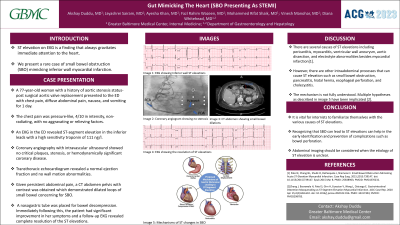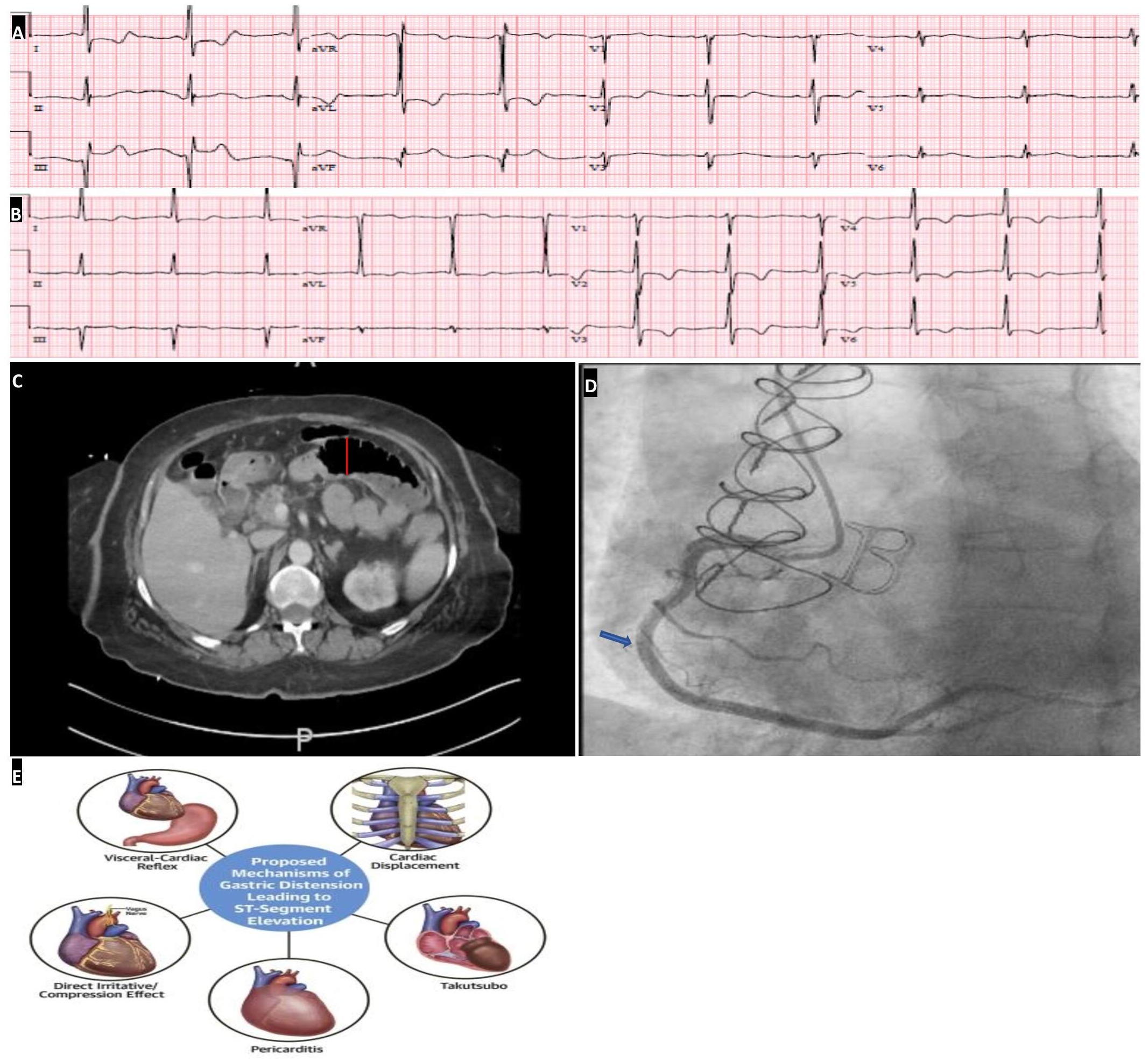Tuesday Poster Session
Category: Small Intestine
P4138 - Gut Mimicking the Heart (SBO Presenting as STEMI)
Tuesday, October 24, 2023
10:30 AM - 4:00 PM PT
Location: Exhibit Hall

Has Audio
- AD
Akshay Duddu, MD
Greater Baltimore Medical Center
Towson, MD
Presenting Author(s)
Award: Presidential Poster Award
Akshay Duddu, MD1, Jayashrei Sairam, MD1, Ayesha Khan, MD1, Fazl Rahim Wazeen, MD1, Mohammed Rifat Shaik, MBBS2, Vinesh Manohar, MD1, Diana Whitehead, MD1
1Greater Baltimore Medical Center, Towson, MD; 2University of Maryland Medical Center Midtown Campus, Baltimore, MD
Introduction: ST elevations on electrocardiogram (EKG) is a finding that always gravitates immediate attention to the heart. We present a fascinating case of small bowel obstruction (SBO) mimicking inferior wall myocardial infarction.
Case Description/Methods: A 77 year old woman with a history of aortic stenosis status post surgical aortic valve replacement (SAVR) presented to the emergency department (ED) with chest pain, diffuse abdominal pain, nausea, and vomiting for 1 day. The chest pain was pressure-like, 4/10 in intensity, non-radiating, with no aggravating or relieving factors. An EKG in the ED revealed ST elevations in the inferior leads with high sensitivity troponin of 111 ng/dl. She subsequently underwent a left heart catheterization which revealed no critical plaques or stenosis. The absence of hemodynamically significant coronary disease was confirmed with intravascular ultrasound. A transthoracic echocardiogram revealed a normal ejection fraction with no wall motion abnormalities. However, due to her persistent nausea and abdominal pain, a CT of the abdomen/pelvis with contrast was obtained and showed dilated loops of small bowel suggestive of small bowel obstruction. Nasogastric tube was placed for bowel decompression. Shortly after decompression of bowels, the patient had significant improvement in her symptoms and a follow-up EKG revealed complete resolution of the ST elevations.
Discussion: There are several causes for ST elevations including pericarditis, myocarditis, ventricular wall aneurysm, aortic dissection, and electrolyte abnormalities besides myocardial infarction. However, there are other intra-abdominal processes that can cause ST elevations such as SBO, pancreatitis, hiatal hernia, esophageal perforation, and cholecystitis. The mechanism of small bowel obstruction leading to ST elevations remains unclear. It is hypothesized that intra-abdominal distention can cause diaphragmatic elevation leading to irritation of the diaphragmatic border of the heart with resultant ST changes. Other hypotheses include a deviation in the mean QRS axis due to displacement of intrathoracic contents and viscero-cardiac reflex leading to increasing vagal tone. Recognizing that intra-abdominal processes such as SBO can lead to ST elevations helps in the early identification and prevention of complications such as bowel perforation. Abdominal imaging should be considered when the etiology of ST elevations is unclear.

Disclosures:
Akshay Duddu, MD1, Jayashrei Sairam, MD1, Ayesha Khan, MD1, Fazl Rahim Wazeen, MD1, Mohammed Rifat Shaik, MBBS2, Vinesh Manohar, MD1, Diana Whitehead, MD1. P4138 - Gut Mimicking the Heart (SBO Presenting as STEMI), ACG 2023 Annual Scientific Meeting Abstracts. Vancouver, BC, Canada: American College of Gastroenterology.
Akshay Duddu, MD1, Jayashrei Sairam, MD1, Ayesha Khan, MD1, Fazl Rahim Wazeen, MD1, Mohammed Rifat Shaik, MBBS2, Vinesh Manohar, MD1, Diana Whitehead, MD1
1Greater Baltimore Medical Center, Towson, MD; 2University of Maryland Medical Center Midtown Campus, Baltimore, MD
Introduction: ST elevations on electrocardiogram (EKG) is a finding that always gravitates immediate attention to the heart. We present a fascinating case of small bowel obstruction (SBO) mimicking inferior wall myocardial infarction.
Case Description/Methods: A 77 year old woman with a history of aortic stenosis status post surgical aortic valve replacement (SAVR) presented to the emergency department (ED) with chest pain, diffuse abdominal pain, nausea, and vomiting for 1 day. The chest pain was pressure-like, 4/10 in intensity, non-radiating, with no aggravating or relieving factors. An EKG in the ED revealed ST elevations in the inferior leads with high sensitivity troponin of 111 ng/dl. She subsequently underwent a left heart catheterization which revealed no critical plaques or stenosis. The absence of hemodynamically significant coronary disease was confirmed with intravascular ultrasound. A transthoracic echocardiogram revealed a normal ejection fraction with no wall motion abnormalities. However, due to her persistent nausea and abdominal pain, a CT of the abdomen/pelvis with contrast was obtained and showed dilated loops of small bowel suggestive of small bowel obstruction. Nasogastric tube was placed for bowel decompression. Shortly after decompression of bowels, the patient had significant improvement in her symptoms and a follow-up EKG revealed complete resolution of the ST elevations.
Discussion: There are several causes for ST elevations including pericarditis, myocarditis, ventricular wall aneurysm, aortic dissection, and electrolyte abnormalities besides myocardial infarction. However, there are other intra-abdominal processes that can cause ST elevations such as SBO, pancreatitis, hiatal hernia, esophageal perforation, and cholecystitis. The mechanism of small bowel obstruction leading to ST elevations remains unclear. It is hypothesized that intra-abdominal distention can cause diaphragmatic elevation leading to irritation of the diaphragmatic border of the heart with resultant ST changes. Other hypotheses include a deviation in the mean QRS axis due to displacement of intrathoracic contents and viscero-cardiac reflex leading to increasing vagal tone. Recognizing that intra-abdominal processes such as SBO can lead to ST elevations helps in the early identification and prevention of complications such as bowel perforation. Abdominal imaging should be considered when the etiology of ST elevations is unclear.

Figure: Image A: EKG showing inferior wall ST elevations; Image B: EKG showing resolution of ST elevations; Image C: Computed tomography displaying small bowel dilation (Red line showing small bowel dilation to 41 mm); Image D: Coronary angiogram showing patent right coronary artery (Blue arrow); Image E: Possible mechanisms of ST changes seen in small bowel obstruction
Disclosures:
Akshay Duddu indicated no relevant financial relationships.
Jayashrei Sairam indicated no relevant financial relationships.
Ayesha Khan indicated no relevant financial relationships.
Fazl Rahim Wazeen indicated no relevant financial relationships.
Mohammed Rifat Shaik indicated no relevant financial relationships.
Vinesh Manohar indicated no relevant financial relationships.
Diana Whitehead indicated no relevant financial relationships.
Akshay Duddu, MD1, Jayashrei Sairam, MD1, Ayesha Khan, MD1, Fazl Rahim Wazeen, MD1, Mohammed Rifat Shaik, MBBS2, Vinesh Manohar, MD1, Diana Whitehead, MD1. P4138 - Gut Mimicking the Heart (SBO Presenting as STEMI), ACG 2023 Annual Scientific Meeting Abstracts. Vancouver, BC, Canada: American College of Gastroenterology.

